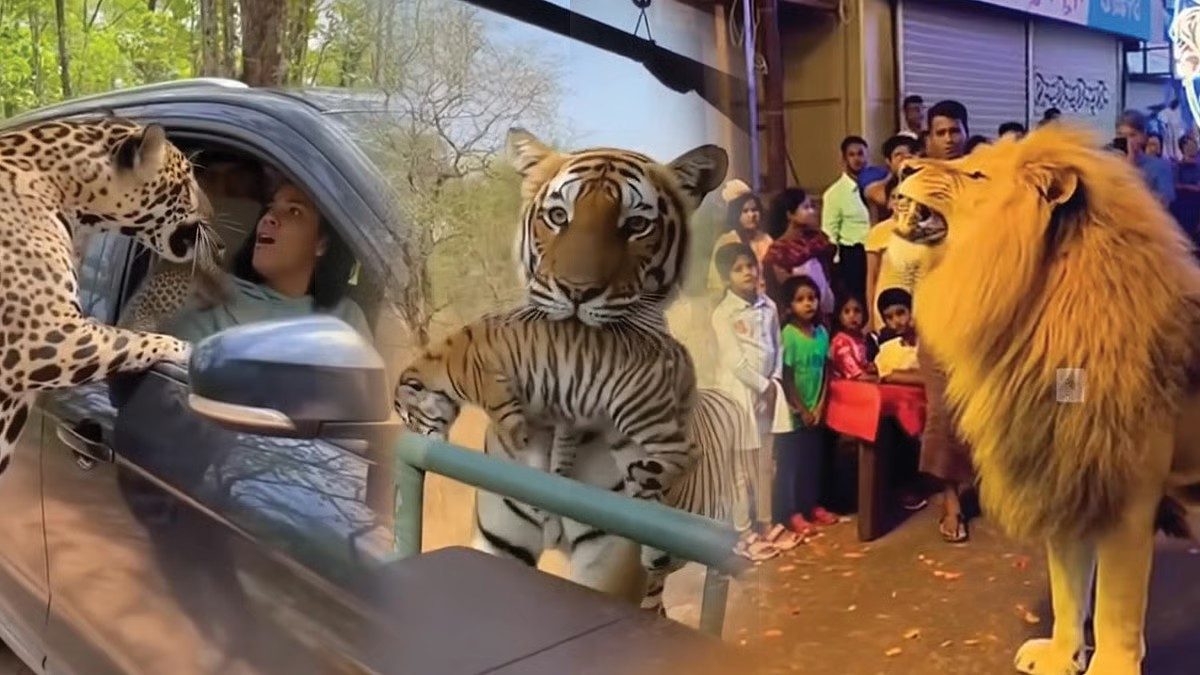Chadi mujhe yaari teri aisi...Jaise daaru desi! (My friend, your friendship is like local alcohol, intense and unforgettable!) A man walking in the middle of the night, with a bottle of local liquor in hand, and suddenly comes face-to-face with a Royal Bengal Tiger. The drunk man thought, why not make the tiger a friend over a drink. And, astonishingly, the tiger too, bent down and took a sip straight from the bottle.
Among the most viral videos across the country in the past week is a video of a tiger and a "drunk man" on a street of Pench. The AI-generated six-second clip has amassed a few million views.
Thanks to social media monetisation policies, the content creator is likely pocketing a few hundred dollars. But how many knew all this was fake, just a digital creation made from a prompt and blended with reality?
That's not where it ends! In the summer, a tiger jumped over a wall onto a boy sitting on the roof of his house. He was scolded again by the house's pet dog. The tiger let out a scream and ran away from its prey in fear.
Also Read | Viral tiger attack video sparks fear in Maharashtra, but officials say it’s….
Whether it is a lion roaming around Chandannagar during the Jagaddhatri Puja to eat sweets, or a tiger leaping from the Sundarbans into a fisherman's boat in the middle of a river, all of it is AI-generated, but viral nonetheless. Just like the video of a leopard carrying its cub in its mouth and approaching a woman driving on a forest road, which has already been seen by 72 million people.
The introduction of such videos raises concern among wildlife experts that these could soon distort the understanding of human–wildlife interaction. AI-generated "near-real" videos can deceive even the rational mind. And since human encounters with wild animals can be both peaceful and conflict-prone, many viewers initially accept these surreal events as real. Then they share them further-making it viral.
Divyendu Mondal, program lead at the Sankala Foundation, told Ei Samay, “AI is being used for human-wildlife conflict mitigation and to promote coexistence in India, content creators are also increasingly exploiting AI to generate animal photos and videos, which could have long-term unintended consequences and potentially undermine the coexistence model.”
What kind of harm? Expert cites the exact
Divyendu adds, “On one hand, AI-generated realistic videos showing people or children petting wild animals may lead to a loss of fear or disregard for maintaining a safe distance when such animals are encountered in real life. On the other hand, content depicting wild animals attacking or swallowing humans can result in their vilification. As a '90s kid, I used to think forests were devoid of humans or roads, thanks to my regular doses of African Savannah shows on Discovery and NatGeo - a notion that was broken during my first visit to an Indian park. Visual media greatly shape how we perceive the world. We don’t encounter wild animals only during guided safaris; we might also come across them in a number of ways.”
“Such AI-generated content, easily accessible to people with limited knowledge of wildlife, or children, can be dangerous - it might lead someone to attempt a selfie with a wild animal after seeing a petting video, or provoke hostility toward them after viewing sensationalised attack videos leading to conflict.”
Also Read | Planning a jungle safari? Here are 8 tips you should know
Sanctuary Asia's Bittu Sehgal warns against 'stupid' AI wildlife fakes
Veteran wildlife expert Bittu Sehgal dismisses the hype, thus, “Any video or post showing wild animals gets massive views, and it pays well. But AI-generated content is often plainly ‘stupid’-there’s no logic or reasoning, just a few seconds of comic shock.”
He told Ei Samay, “Millions of content creators make such AI-based videos every day. You can’t stop them through the law; the only way is to block them. On our magazine Sanctuary Asia’s social media accounts, we have blocked over 60,000 users for this reason. It has now become a regular procedure to ensure our audience receives only genuine content.”
But do such "absurd yet almost real" videos have harmful effects? Bittu says, "Earlier, we believed pictures don't lie. Now, before seeing an image, you have to ask-was it captured by someone, or digitally created? In the age of technology, you have to learn to deal with misuse. People don't realise that a tiger and a leopard climb differently, or that their weights differ. Those who do know should caution others about AI videos."
Notably, a few days ago, someone created an AI video showing a cheetah wandering outside his house in Ashiyana, Lucknow, Uttar Pradesh. The area wore a panicky look, though the forest department assured no wild animal was present. Police intervened, and according to SHO Chhatrapal Singh, “We arrested him, made him sign a written assurance, and released him.”
Currently, the Indian wildlife laws have no provisions to curb AI deepfake content. “AI technology has spread rapidly in the past two to three years. We are guardians of wildlife, but the impact of these deepfakes hasn’t been properly discussed yet. Hopefully, policies will address this in the future,” a forest officer states. Meanwhile… would you believe that a lion's favourite snack is sweets?










